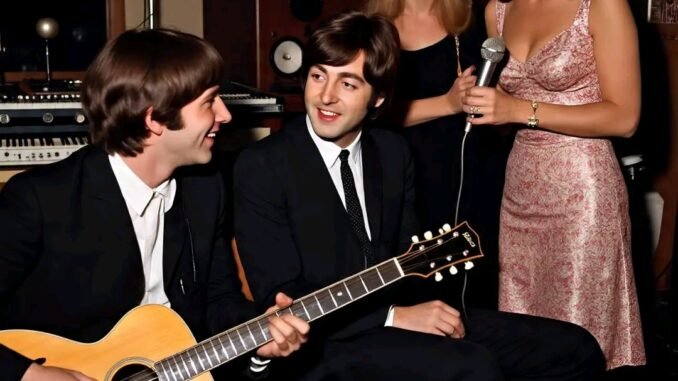
What if the Beatles met the Chordettes?
What a fab idea! Imagine John, Paul, George, and Ringo jamming with Lynn Evans, Janet Ertel, Alice Mae Buschmann, and Dorothy Schwartz! The Beatles’ rock vibes would blend so cool with the Chordettes’ harmonies. They’d create magic together, maybe even a fusion of “I Want to Hold Your Hand” and “Mr. Sandman”! What song would you want them to mash up?
What if the British Invasion collided head-on with the golden harmonies of 1950s America? Imagine it: The Beatles—John, Paul, George, and Ringo—fresh off their meteoric rise in the early 1960s, walking into a vintage recording studio to find none other than the Chordettes—Lynn Evans, Janet Ertel, Alice Mae Buschmann, and Dorothy Schwartz—warming up their signature harmonies around an old-fashioned microphone.
It sounds like a dream, right? But let’s suspend disbelief for a moment and paint the picture of what could have been one of the most intriguing and genre-blending collaborations in pop history.Setting the Stage: A Meeting of Eras
By the time the Beatles burst onto the global stage in 1963, the Chordettes were already legends in their own right. Their hits like “Mr. Sandman” and “Lollipop” had become emblematic of the dreamy innocence and tight vocal harmony of 1950s girl groups. The Beatles, meanwhile, were redefining pop music with their rock ‘n’ roll energy, British charm, and increasingly sophisticated songwriting.
Musically, these two groups may have seemed worlds apart, but underneath the surface, they shared something profound: an appreciation for melody, harmony, and the joy of musical expression. The Beatles were known to draw influence from American doo-wop and vocal groups, and it’s not hard to imagine that a part of them admired the precision and sweetness of the Chordettes’ sound.
Let’s imagine the meeting. Picture it: Abbey Road Studios, 1964. The Chordettes are invited as special guests to London. There’s tea on a side table, a haze of cigarette smoke in the air, and Paul’s Hofner bass leaning against a worn amp. As the ladies warm up with a few bars of “Born to Be With You,” the Beatles lean in, fascinated by the purity of their voices. John grins. “Fancy trying something together?”A Fusion of Styles: Mr. Sandman Meets Beatlemania
If they were to collaborate on a mash-up, what better place to start than the two most iconic songs from their respective catalogs? The whimsical charm of “Mr. Sandman” fused with the raw, ecstatic energy of “I Want to Hold Your Hand” could produce something surreal—a track that leaps across decades, from sock hops to screaming stadiums.
The arrangement might start with the soft, bell-like “bum bum bum bum…” of “Mr. Sandman,” backed by George Harrison’s clean, jangly guitar lines. Then, as the Chordettes invite Mr. Sandman to bring them a dream, John and Paul jump in with their harmonized “Oh yeah, I’ll tell you something…”—a call-and-response that transforms the romantic plea into a playful back-and-forth between two eras of pop idealism.
Imagine Ringo tapping out a brushy jazz beat at first, in the spirit of the 1950s, before switching to his classic driving rhythm to usher in the rock groove. The middle eight might blend both songs in counterpoint: the Chordettes layering their harmonies beneath Paul’s exuberant lead vocals, creating a delicious wall of sound that blurs the line between doo-wop and Merseybeat.Style vs. Substance? Nope—Just Harmony
It’s tempting to say the Beatles were about rebellion and innovation while the Chordettes represented a more innocent time, but that would be selling both groups short. The Chordettes, though polished, were groundbreaking in their own right—female vocalists carving out space in a male-dominated industry. Their control, harmonies, and musical discipline were top-tier. The Beatles, meanwhile, were far from simple rockers; even in their early years, they had an ear for complex arrangements, three-part harmonies, and genre-melding creativity.
A collaboration would not just be a stylistic mash-up—it would be a meeting of musical minds. Paul McCartney, especially, with his fondness for music hall and pre-rock influences, would have found kindred spirits in the Chordettes. John Lennon’s ironic edge might have played hilariously off the sweet lyrics of “Lollipop.” George, ever the quiet and versatile one, could have added subtle guitar lines that gave depth to their sugary harmonies. And Ringo? He’d keep the whole thing grooving with a grin.
The Imaginary Tracklist
If we’re really dreaming, why stop at one mash-up? Imagine a full EP:“Mr. Handman” – A fusion of “Mr. Sandman” and “I Want to Hold Your Hand.” A cheerful opener with dueling harmonies.“Lollipop Lane” – A cheeky, upbeat track with John and Dorothy trading vocals.“Love Me Do (And Send Me a Dream)” – A slowed-down, harmony-heavy reimagining of the Beatles’ debut single.“Please Please Me, Mr. Sandman” – A cleverly arranged medley that starts with the Chordettes’ dreamy vocals and bursts into the Beatles’ early hit.“Till There Was You” (Live in Harmony) – A live-style closer that showcases both groups’ shared love for classic songwriting.Legacy and What Could Have Been
In reality, the Beatles didn’t collaborate with many vocal harmony groups, and the Chordettes’ style had largely fallen out of fashion by the time Beatlemania took over the world. But in an alternate musical universe, their voices might have met in the middle—somewhere between Liverpool and Sheboygan, harmonizing on love, dreams, and hand-holding.
Perhaps the true magic of this imagined meeting lies in what both groups represent: a love of music that transcends trends. The Beatles evolved rapidly, but they never lost their melodic heart. The Chordettes, though tied to a specific era, created harmonies so timeless they’re still used in films, commercials, and TV today.
In a way, they’ve already met—in the DNA of pop music. And if you close your eyes and listen just right, maybe you can hear them singing together.
Now the only question is: would you buy that record?Would you like a visual concept for the album cover too?
Leave a Reply